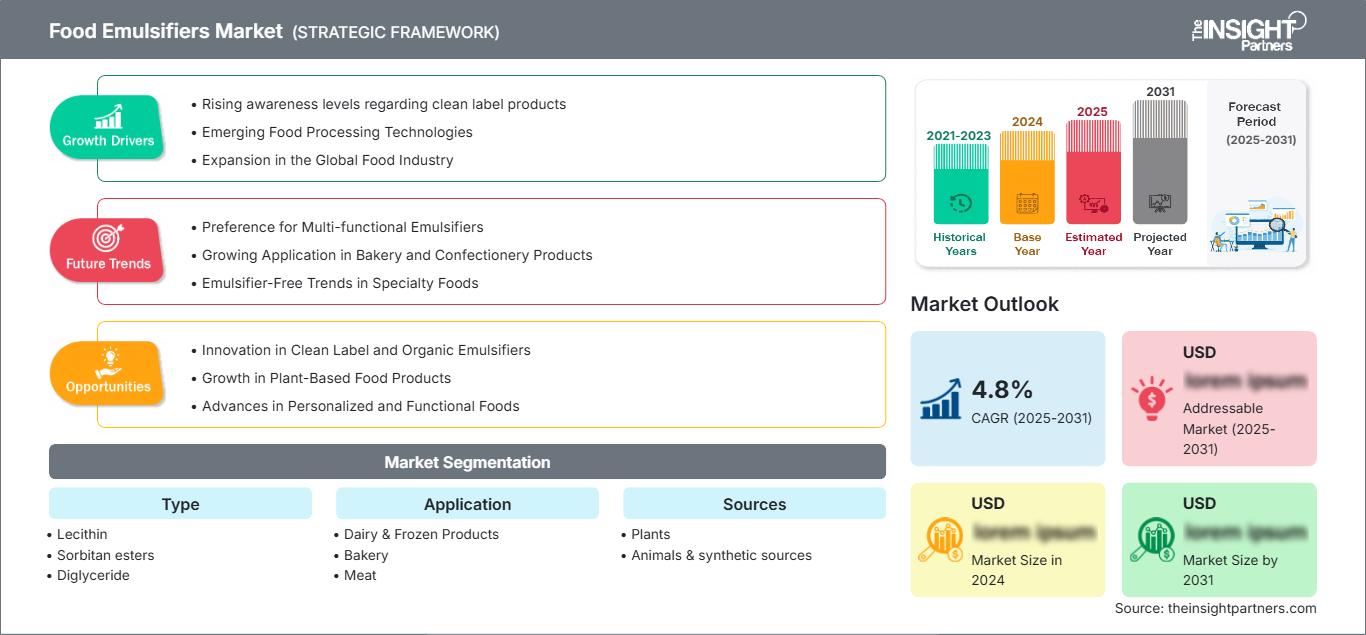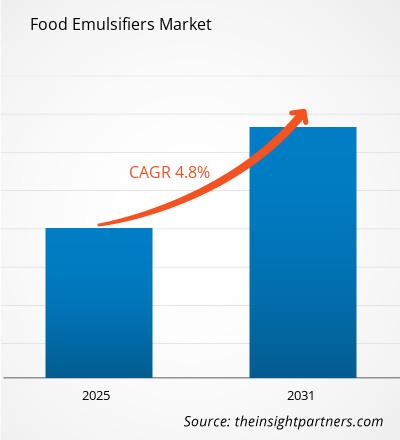The Food Emulsifiers Market is expected to register a CAGR of 4.8% from 2025 to 2031, with a market size expanding from US$ XX million in 2024 to US$ XX Million by 2031.
The Food Emulsifiers Market report covers analysis By Type (Lecithin, Sorbitan esters, Diglyceride, Polyglycerol Ester, and Others); Application (Dairy & Frozen Products, Bakery, Meat, Poultry & Seafood, Beverage, Confectionery, and Others); Sources (Plants, Animals & synthetic sources) and Geography. The global analysis is further broken-down at regional level and major countries. The Report Offers the Value in USD for the above analysis and segments.
Purpose of the Report
The report Food Emulsifiers Market by The Insight Partners aims to describe the present landscape and future growth, top driving factors, challenges, and opportunities. This will provide insights to various business stakeholders, such as:
- Technology Providers/Manufacturers: To understand the evolving market dynamics and know the potential growth opportunities, enabling them to make informed strategic decisions.
- Investors: To conduct a comprehensive trend analysis regarding the market growth rate, market financial projections, and opportunities that exist across the value chain.
- Regulatory bodies: To regulate policies and police activities in the market with the aim of minimizing abuse, preserving investor trust and confidence, and upholding the integrity and stability of the market.
Food Emulsifiers Market Segmentation
Type
- Lecithin
- Sorbitan esters
- Diglyceride
- Polyglycerol Ester
Application
- Dairy & Frozen Products
- Bakery
- Meat
- Poultry & Seafood
- Beverage
- Confectionery
Sources
- Plants
- Animals & synthetic sources
Geography
- North America
- Europe
- Asia-Pacific
- South and Central America
- Middle East and Africa
You will get customization on any report - free of charge - including parts of this report, or country-level analysis, Excel Data pack, as well as avail great offers and discounts for start-ups & universities
Food Emulsifiers Market: Strategic Insights

-
Get Top Key Market Trends of this report.This FREE sample will include data analysis, ranging from market trends to estimates and forecasts.
Food Emulsifiers Market Growth Drivers
- Rising awareness levels regarding clean label products:
Consumers are demanding more natural and clean-label ingredients in food products. As a result, there is an increased demand for natural food emulsifiers sourced from plant-based or animal-based sources, thus creating a drive for innovation and demand for clean-label emulsifiers.
- Emerging Food Processing Technologies:
Technological advancements in food processing are making it possible to use emulsifiers more efficiently and in a wider variety of applications. Formulations that improve stability, texture, and mouthfeel are encouraging manufacturers to include these ingredients in a wider variety of products.
- Expansion in the Global Food Industry:
The global food industry, particularly in emerging markets, continues to expand and fuel the demand for food emulsifiers. Improving disposable incomes, increased urbanization, and growing food service sectors in the said regions are some factors leading to market growth.
Food Emulsifiers Market Future Trends
- Preference for Multi-functional Emulsifiers:
Multi-functional emulsifiers that offer additional benefits, such as improving texture, stability, and product appearance, are gaining popularity. These emulsifiers are highly effective in reducing production costs while improving the overall quality of food products.
- Growing Application in Bakery and Confectionery Products:
The bakery and confectionery industries are among the largest consumers of food emulsifiers. As demand for baked goods and sweet treats continues to rise, particularly in emerging markets, emulsifiers are increasingly used to improve the texture, moisture retention, and shelf life of these products.
- Emulsifier-Free Trends in Specialty Foods:
While emulsifiers are widely used in mainstream food products, there is a counter-trend in the specialty foods market where products are being developed without emulsifiers to appeal to health-conscious consumers. This trend is leading to the development of alternative ingredients and formulations.
Food Emulsifiers Market Opportunities
- Innovation in Clean Label and Organic Emulsifiers:
As the clean label trend grows, there is an opportunity for manufacturers to develop organic and natural emulsifiers that meet consumer demand for healthier and more transparent food products. This segment is expected to grow as consumers demand more sustainable and ethically sourced ingredients.
- Growth in Plant-Based Food Products:
The rising popularity of plant-based foods, including dairy alternatives, plant-based meats, and vegan baked goods, creates new opportunities for food emulsifiers. Plant-based emulsifiers can be used in these products to maintain texture, consistency, and stability, driving market expansion.
- Advances in Personalized and Functional Foods:
The trend towards personalized nutrition and functional foods presents opportunities for food emulsifier manufacturers to develop targeted emulsifiers for specific health benefits, such as those supporting digestive health, immunity, or weight management.
Food Emulsifiers Market Regional Insights
The regional trends and factors influencing the Food Emulsifiers Market throughout the forecast period have been thoroughly explained by the analysts at The Insight Partners. This section also discusses Food Emulsifiers Market segments and geography across North America, Europe, Asia Pacific, Middle East and Africa, and South and Central America.
Food Emulsifiers Market Report Scope
| Report Attribute | Details |
|---|---|
| Market size in 2024 | US$ XX million |
| Market Size by 2031 | US$ XX Million |
| Global CAGR (2025 - 2031) | 4.8% |
| Historical Data | 2021-2023 |
| Forecast period | 2025-2031 |
| Segments Covered |
By Type
|
| Regions and Countries Covered |
North America
|
| Market leaders and key company profiles |
|
Food Emulsifiers Market Players Density: Understanding Its Impact on Business Dynamics
The Food Emulsifiers Market is growing rapidly, driven by increasing end-user demand due to factors such as evolving consumer preferences, technological advancements, and greater awareness of the product's benefits. As demand rises, businesses are expanding their offerings, innovating to meet consumer needs, and capitalizing on emerging trends, which further fuels market growth.

- Get the Food Emulsifiers Market top key players overview
Key Selling Points
- Comprehensive Coverage: The report comprehensively covers the analysis of products, services, types, and end users of the Food Emulsifiers Market, providing a holistic landscape.
- Expert Analysis: The report is compiled based on the in-depth understanding of industry experts and analysts.
- Up-to-date Information: The report assures business relevance due to its coverage of recent information and data trends.
- Customization Options: This report can be customized to cater to specific client requirements and suit the business strategies aptly.
The research report on the Food Emulsifiers Market can, therefore, help spearhead the trail of decoding and understanding the industry scenario and growth prospects. Although there can be a few valid concerns, the overall benefits of this report tend to outweigh the disadvantages.
Frequently Asked Questions
What are the options available for the customization of this report?
What are the deliverable formats of this report?
Which are the key players in the Food Emulsifiers Market?
What are the future trends in the Food Emulsifiers Market?
What is the expected CAGR of the Food Emulsifiers Market?
What are the driving factors impacting the Food Emulsifiers Market?
- Historical Analysis (2 Years), Base Year, Forecast (7 Years) with CAGR
- PEST and SWOT Analysis
- Market Size Value / Volume - Global, Regional, Country
- Industry and Competitive Landscape
- Excel Dataset
Recent Reports
Related Reports
Testimonials
Reason to Buy
- Informed Decision-Making
- Understanding Market Dynamics
- Competitive Analysis
- Identifying Emerging Markets
- Customer Insights
- Market Forecasts
- Risk Mitigation
- Boosting Operational Efficiency
- Strategic Planning
- Investment Justification
- Tracking Industry Innovations
- Aligning with Regulatory Trends





















 Get Free Sample For
Get Free Sample For